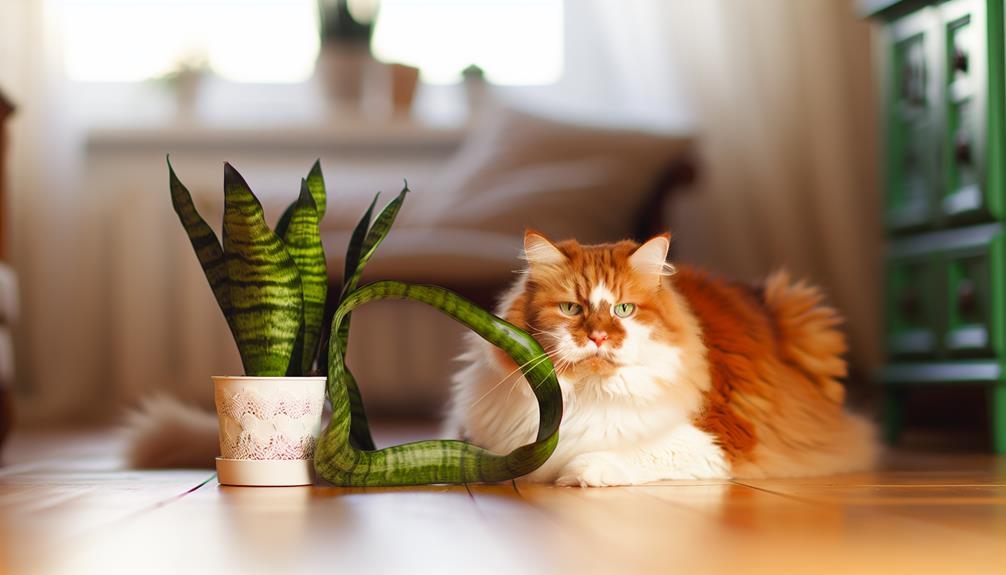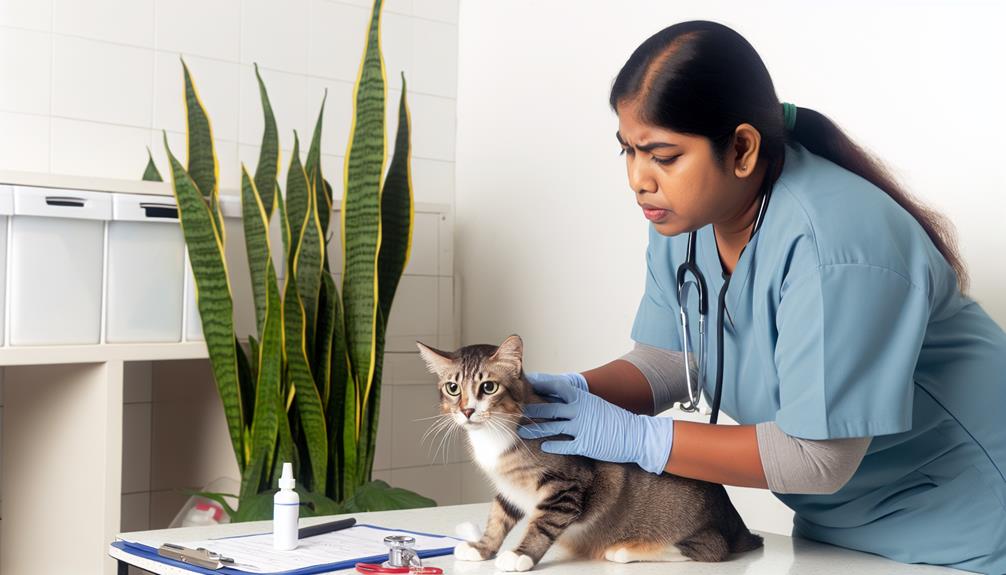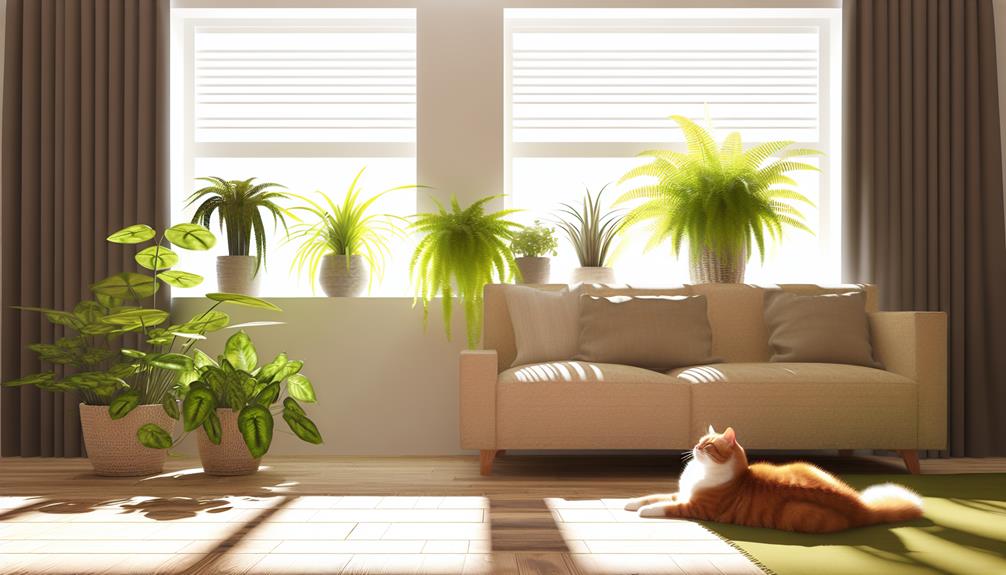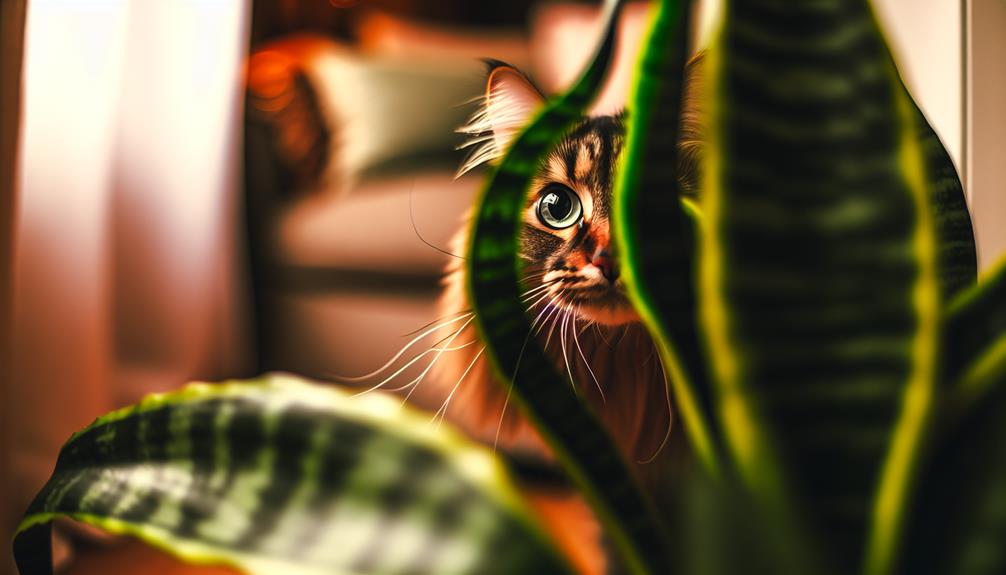You've probably heard that certain household plants can be dangerous to pets, but have you thought about your snake plant? Known scientifically as *Sansevieria trifasciata*, this popular houseplant contains saponins, which can irritate your cat's gastrointestinal system. If your feline friend gets a nibble, symptoms like drooling, vomiting, and diarrhea might follow. The severity can vary, so it's essential to know what steps to take next. Wondering how to keep your cat safe while still enjoying greenery at home? Let's explore some practical solutions and alternative plants that won't compromise your pet's health.
Understanding Snake Plants
Understanding snake plants, scientifically known as *Sansevieria trifasciata*, necessitates a grasp of their unique physiological attributes. These perennial, evergreen plants are distinguished by their upright, sword-shaped leaves, which are not only visually appealing but also highly efficient at photosynthesis. The leaves' thick, waxy cuticle minimizes water loss, making snake plants particularly well-suited for indoor gardening.
When you're delving into snake plant care, it's essential to recognize their resilience. They thrive under a wide range of light conditions, from low, indirect light to bright, direct sunlight. However, ideal growth is typically observed in moderate, indirect light. Overexposure to direct sunlight may cause leaf burn, characterized by brown, crispy edges. Conversely, insufficient light can result in leggy or etiolated growth, where leaves become elongated and pale.
Watering practices are a vital aspect of snake plant care. Due to their succulent nature, snake plants prefer infrequent watering. Soil must be allowed to dry out completely between waterings to prevent root rot, a common issue arising from overwatering. During the dormant winter months, you'll find that the watering frequency should be greatly reduced.
The soil substrate should be well-draining, ideally composed of a mix containing sand or perlite. This guarantees that water doesn't stagnate around the roots, which could otherwise lead to fungal infections. Additionally, snake plants benefit from occasional feeding with a balanced, diluted fertilizer during the growing season.
In indoor gardening, snake plants are valued for their air-purifying properties. Studies have demonstrated their ability to filter volatile organic compounds (VOCs) such as formaldehyde and benzene from the air, contributing to a healthier indoor environment. Understanding these care nuances guarantees your snake plant remains robust and aesthetically pleasing.
Toxicity in Cats
While snake plants offer numerous benefits for indoor gardening, pet owners must be cautious due to their toxicity to cats. The primary toxic component in snake plants (Sansevieria trifasciata) is saponins, which serve as a natural defense mechanism for the plant. When ingested, saponins can disrupt normal cellular function in cats, leading to a cascade of adverse health effects.
For maintaining cat health, understanding the potential risks associated with snake plants is essential. Saponins are known to cause gastrointestinal irritation, which can result in symptoms like vomiting and diarrhea. The severity of these symptoms can vary based on the amount of plant material ingested and the size of your cat. Smaller cats are generally at higher risk due to their lower body mass.
From a diagnostic approach, if you suspect your cat has ingested part of a snake plant, it's imperative to consult a veterinarian immediately. Diagnostic tests may include a physical examination, blood tests, and possibly imaging studies to assess the extent of the toxicity. Early identification and intervention are key to mitigating serious complications.
In terms of plant safety, it's advisable to keep snake plants out of your cat's reach. Consider placing them in elevated positions or rooms that your cat doesn't have access to. You could also opt for non-toxic plants as safer alternatives to guarantee your indoor greenery doesn't compromise your cat's well-being.
Signs of Poisoning

If your cat ingests a snake plant, you might observe clinical signs like vomiting, diarrhea, and excessive drooling. Immediate intervention includes rinsing your cat's mouth with water and preventing further ingestion. Contact your veterinarian promptly for guidance on additional necessary treatments.
Common Poisoning Symptoms
When cats ingest parts of a snake plant, they can exhibit several common poisoning symptoms that warrant immediate attention. Initial signs often include gastrointestinal disturbances such as vomiting and diarrhea. These symptoms can vary in severity depending on the amount ingested and the individual cat's sensitivity. In more severe cases, you might observe excessive drooling, lethargy, and a decrease in appetite.
Respiratory distress can also occur, characterized by rapid breathing or wheezing. Neurological symptoms like tremors or seizures are rare but indicate a more serious level of toxicity. The severity of these symptoms can escalate quickly, making prompt veterinary care significant.
Long-term effects are generally uncommon but can include prolonged gastrointestinal upset and potential damage to the liver or kidneys if the poisoning is severe and not promptly treated. Monitoring your cat for changes in behavior or persistent symptoms over the following days is essential.
Immediate Treatment Steps
At the onset of noticing signs of poisoning in your cat, immediate intervention is vital. Initial symptoms such as drooling, vomiting, or lethargy indicate the need for prompt action. Begin by removing any plant material from your cat's mouth to prevent further ingestion. Rinse their mouth with water to dilute any residual toxins.
Next, consider some home remedies to mitigate the poisoning effects. Activated charcoal can be administered to absorb toxins in the gastrointestinal tract. Verify your cat stays hydrated by offering small amounts of water or an electrolyte solution.
To better understand the immediate steps, refer to the table below:
| Symptoms | Immediate Steps | Home Remedies |
|---|---|---|
| Drooling | Remove plant material, rinse mouth | Offer small water sips |
| Vomiting | Observe vomiting frequency | Administer activated charcoal |
| Lethargy | Keep the environment calm and quiet | Electrolyte solution |
While managing the immediate symptoms, inspect your snake plant for signs of damage or ingestion. Proper plant care guarantees fewer loose leaves that might tempt your cat. Remember, these steps are preliminary measures. Constant monitoring of your cat's condition is vital to verify they don't deteriorate.
When to Contact Vet
Recognizing the vital moment to contact your veterinarian can greatly impact your cat's recovery from snake plant poisoning. If you observe changes in cat behavior such as excessive drooling, vomiting, or diarrhea, these symptoms may indicate saponin ingestion from the snake plant. Saponins, the toxic compounds found in snake plants, can cause gastrointestinal distress in felines.
For pet safety, monitor your cat for more severe signs like lethargy, difficulty breathing, or tremors. These can denote a more serious reaction requiring immediate veterinary intervention. A diagnostic approach involves noting the onset and severity of symptoms, any changes in your cat's routine, and potential exposure to the snake plant.
In some cases, you might notice your cat pawing at its mouth or refusing food and water, further indicating discomfort and potential poisoning. It's essential not to delay seeking professional help, as early intervention can prevent complications. Always err on the side of caution to guarantee your cat receives prompt, appropriate care. By staying vigilant and responsive to changes in cat behavior, you can notably enhance your pet's safety and well-being.
Immediate Actions
If you notice symptoms of poisoning such as vomiting or lethargy in your cat, it's essential to contact a veterinarian immediately. Provide them with specific details about the ingestion and symptoms observed. Meanwhile, make certain your cat doesn't ingest any more of the snake plant by isolating it from the affected area.
Identify Poisoning Symptoms
Many pet owners may not immediately realize their cat has ingested a toxic plant. If you suspect your cat has chewed on a snake plant, it's vital to observe them for signs of poisoning. The severity of poisoning can vary, and symptoms may manifest within a short symptom duration, typically within a few hours. Clinical signs to watch for include excessive drooling, vomiting, and diarrhea. You might also notice a decrease in appetite and signs of lethargy.
In more severe cases, cats may exhibit tremors, difficulty breathing, or even seizures. Such symptoms indicate a higher poisoning severity and necessitate urgent attention. Monitoring your cat's behavior closely is essential; sudden changes could indicate toxin ingestion.
Respiratory rate, heart rate, and mucous membrane color are diagnostic indicators veterinarians use, but you can also check for pale or blue gums, which are signs of oxygen deficiency. Remember, early identification of poisoning symptoms can greatly impact the outcome. If you observe any of these symptoms, it's critical to act immediately. While the next steps will be discussed in the following subtopic, recognizing these signs promptly is the first step in ensuring your cat's safety.
Contact a Veterinarian
Upon noticing signs of snake plant poisoning in your cat, immediately contact a veterinarian to guarantee your pet receives the necessary care. Snake plant toxicity can manifest through symptoms such as vomiting, diarrhea, and lethargy. Given the potential severity, a prompt vet consultation is crucial for pet safety.
During the vet consultation, the veterinarian will likely ask for a detailed history of your cat's exposure to the snake plant. They may inquire about the quantity ingested and the time elapsed since ingestion. Diagnostic approaches may include a thorough physical examination, blood tests, and possibly imaging studies to assess the extent of toxicity.
Treatment protocols vary based on the severity of the poisoning. Mild cases might only require supportive care, such as hydration and antiemetics. However, more severe cases could necessitate intravenous fluids, activated charcoal to limit toxin absorption, and medications to protect the gastrointestinal tract. Continuous monitoring guarantees your cat's essential signs remain stable and helps track recovery progression.
Prevent Further Ingestion
To prevent further ingestion of the snake plant by your cat, immediate actions are necessary. First, relocate the snake plant to an area that's completely inaccessible to your cat. High shelves or closed rooms are effective solutions. Immediate isolation of the plant guarantees pet safety and minimizes the risk of ongoing exposure to the plant's toxic saponins.
Next, thoroughly inspect your home for other potentially harmful plants. Implementing a detailed plant safety audit is essential. Create a pet-free zone for all toxic plants and replace them with cat-friendly alternatives such as spider plants or Boston ferns.
Additionally, consider using barriers like pet gates to restrict access to specific areas where plants are kept. Employing these strategies will greatly reduce the likelihood of accidental ingestion.
Monitor your cat closely for any signs of distress or symptoms of poisoning, such as vomiting or lethargy. Documenting these observations will provide valuable information for your veterinarian.
Vet Treatment Options

When your cat exhibits symptoms of snake plant poisoning, such as vomiting, drooling, or lethargy, it's vital to consult your veterinarian immediately. A professional diagnosis is significant because these symptoms can overlap with other toxicities or medical conditions. While home remedies might be tempting, they are not advisable in cases of plant poisoning. Instead, prioritize getting your cat to a vet who can provide accurate treatment.
Upon arrival, your vet will likely perform a physical examination and ask for a detailed history, including any known ingestion of snake plants. Diagnostic tests, such as blood work and urinalysis, may be conducted to assess your cat's overall health and organ function. Imaging studies, like X-rays, might be necessary to rule out other potential causes of the symptoms.
Treatment typically begins with decontamination. If ingestion was recent, the vet might induce vomiting to expel the plant material. Activated charcoal can be administered to absorb any remaining toxins in the gastrointestinal tract. Intravenous fluids are often provided to maintain hydration and support kidney function, which can be compromised by the toxins.
Your vet may also prescribe medications to manage symptoms, such as anti-emetics for vomiting or analgesics for pain relief. Continuous monitoring is vital to guarantee your cat's condition stabilizes. The vet will also advise you on follow-up visits and any necessary adjustments to your cat's diet or home environment.
While plant care is important, making sure that your home is free from toxic plants is paramount to your cat's health. Always consult your vet before attempting any home remedies, as improper treatment can exacerbate the problem.
Preventing Exposure
Preventing your cat from being exposed to snake plants is critical for avoiding the distressing symptoms and treatments associated with poisoning. Understanding the interplay between plant placement and cat behavior is essential for creating a safe environment. Here are some evidence-based strategies to mitigate exposure:
- Strategic Plant Placement: Position your snake plants in areas that are inaccessible to your cat. Elevated surfaces, hanging baskets, or rooms where your cat doesn't have access can greatly reduce the risk of ingestion. Research indicates that cats are less likely to interact with plants that are out of their immediate reach.
- Behavioral Modification: Observing and understanding your cat's behavior around plants can provide insights into effective deterrents. Cats are naturally curious, and certain behavioral training techniques, such as using citrus sprays or providing alternative stimuli, can divert their attention away from toxic plants. Studies show that consistent positive reinforcement and environmental enrichment can reduce a cat's inclination to chew on plants.
- Physical Barriers: Implementing physical barriers can be an effective method to prevent access. This could include using plant terrariums, decorative cages, or placing plants behind glass. Evidence supports that physical barriers are one of the most reliable methods to prevent ingestion as they directly obstruct access.
Safe Plant Alternatives

Opting for safe plant alternatives is an essential step in ensuring your cat's health and well-being. When it comes to indoor greenery, not all plants are created equal. Numerous studies have shown that certain houseplants, including the commonly used snake plant (Sansevieria trifasciata), contain saponins, which can be toxic to cats. To mitigate this risk, let's explore cat friendly plants that provide the same aesthetic appeal without the associated hazards.
Spider plants (Chlorophytum comosum) are an excellent choice. They are not only visually appealing but also non-toxic to cats, as confirmed by the ASPCA. Spider plants have also been shown to improve indoor air quality by removing pollutants such as formaldehyde and xylene. Additionally, they are easy to care for, making them an ideal choice for cat owners.
Another beneficial option is the Boston fern (Nephrolepis exaltata). These lush, green fronds are completely safe for your feline friends. Research indicates that Boston ferns can enhance humidity levels in your home, contributing to a healthier respiratory environment for both you and your cat.
Moreover, consider the Areca palm (Dypsis lutescens), a cat friendly plant that is both non-toxic and contributes to improved air quality. According to NASA's Clean Air Study, Areca palms are effective in filtering out xylene and toluene from indoor air.
Conclusion
While snake plants bring aesthetic appeal to your home, their toxicity to cats can't be ignored. Symptoms like vomiting and diarrhea starkly contrast with the plant's serene appearance. If ingestion occurs, immediate veterinary consultation is essential. By opting for non-toxic alternatives like spider plants, you can harmonize your love for greenery with your pet's safety. Consequently, balancing beauty and health becomes not just an option but a necessity in a pet-friendly environment.
